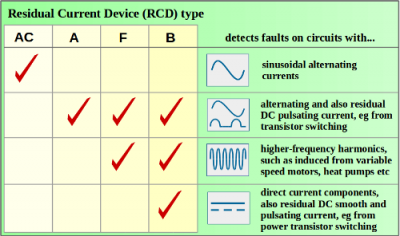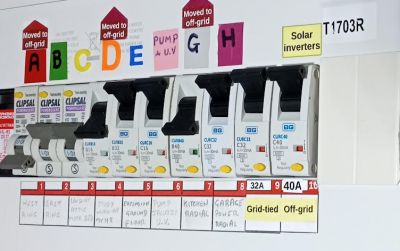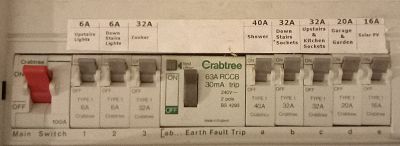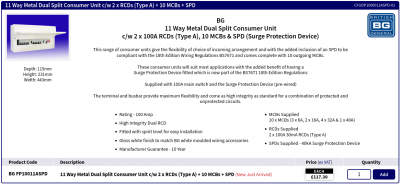PV inverters seem to interact
On 26th Jan I had my faulty loft PV inverter replaced. I opted for a Solis 1.5KW as it's the same as I installed myself on a garden array 2 years back. The next day, about 8:30am the mains tripped on earth leakage. I reset it and everything was ok. Next day, the same again, and the penny dropped. I examined my weatherstation logs for solar intensity and sure enough the trip was just at the point the inverter started to export.
For 10 days now I've been trying different combinations of isolating supply loops to home in on the problem.
I'm now 99% sure that the problem is some sort of interaction between the two inverters. If I unplug the garden inverter from the mains there is no morning trip. Connect it and there's a trip. And when it trips, if I reset it straight away it usually trips again 5 minutes later when the loft inverter starts exporting again. If I reset it a second time it stays reset. The garden PV array has quite a lot of side shade so almost certainly starts to export later than the roof PV.
The fact that the inverter is fine on the second trip reset implies it's not a high residual earth leakage issue. To be sure, I've isolated the garden cable run (underground armoured) and unplugged everything and checked E-L and E-N resistance - no obvious issue.
Does anyone have any bright ideas?
Thanks
I suspect @transparent might 😀
Get a copy of The Ultimate Guide to Heat Pumps
Subscribe and follow our YouTube channel!
Thanks for raising this issue @geo3geo
I've been investigating tripping issues with a set of inverters by Growatt for several months.
We are not alone. There is a similar report over here on the well-respected DIY Solar Power Forum, which is useful because the responder is from the UK and refers to the different types of trip we have available.
We have
- MCBs (Miniature Circuit Breakers) for over-current protection
- RCDs (Residual Current Disconnector) for earth-leakage protection
- RCBO (Residual Current Breaker with Overcurrent) which combines both of the above features in one unit
I'm going to insert here a table showing the different categories of RCD which are presently recognised/approved for UK use,
because we're likely to need it shortly:
Posted by: @geo3geoThe fact that the inverter is fine on the second trip reset implies it's not a high residual earth leakage issue.
I don't think we can conclude that... especially this early in the discussion!
In my case I'm presently using 3x Growatt SPF5000ES (off-grid) inverters fed from a an RCBO rated at 40A, curve-C, and 30mA leakage trip level.
Adjacent to this is an RCBO at 32A, curve-C, 30mA leakage, and supplying a Growatt (grid tied) MIN3600TL-XE inverter
My inverters are all within a 2m cable-run of those trips in the consumer-unit.
Please note the level of detail I'm giving: It matters!
And note also that the SPF5000 inverters use internal transformers,
whilst the "TL" in the model number of the grid-tied inverter stands for "TransformerLess".
Can you please share a similar level of detail on your hardware?
Save energy... recycle electrons!
My inverters are Solis 1.5kW Mini S6 Single Tracker and in the specification is states
Topography - transformerless
The roof inverter is some 10m from the consumer unit, the garden one is about 50m. I've been in this house for 30 years and the consumer unit and earth leakage trip is at least that old. It's ident is Crabtree 63A, 30mA, 2 pole, BS5293
Let me know if you need any more info.
Here is this morning's log for interest:
Mon 12th Feb, garden loop MCB closed, Garden PV isolator closed, garden inverter connected - Earth leakage tripped at 8am. Immediately opened garden loop MCB and reset the RCD. Then closed garden loop MCB, no trip.
Is that Crabtree RCD protecting a number of circuits @geo3geo ?
When it trips out, what else gets affected?
Ignoring the legal aspects, how competent are you on wiring issues?
That would help me to understand the level of detail I can refer to.
Save energy... recycle electrons!
The RCD is protecting the whole house. So when the RCD trips everything goes. The attached image will explain. Solar MCB is for the roof PV, garden PV on the garden spur.
Re. competence I'm not an electrician, not that familiar with regs, but do have a degree in Elec Eng.
An electrical engineering degree is more than adequate for this discussion @geo3geo 🙂
Is this perhaps the moment to consider a new consumer unit?
It looks like the left-hand three MCBs have no earth-leakage protection.
So a faulty cooker would kill you before the trip contacts opened. 😖
Consumer Units are surprisingly cheap....
... and especially so if you buy them pre-populated with a number of different trips.
Have a look at the website for TLC - a trade supplier who also sells to end-users and will deliver direct to you.
To give you space to experiment with the connections to your inverters, what about asking Sparks to place those trips into a separate enclosure with its own DIN-rail.
That could in turn be supplied from a 'standard' 32A MCB in the main consumer unit.
You can then have that secondary enclosure isolated whenever you want to try a different combination of RCD and MCB to link to the two inverters independently.
Save energy... recycle electrons!
@transparent The unit you highlight is certainly cheap. Thanks for the lead. I see the RCB is type A which isn't transient resistant. Could it be that all I need is a transient resistant RCD? I think it's safe to assume is the present Crabtree RCD isn't transient resistant.
I read somewhere that the RCDs age (whatever that means) and should be replaced anyway at some point. Do you know if there's substance to this?
And maybe I need to make proper provision for my EV 13A outside charge socket, which is currently a spur off the downstairs sockets loop. The spur is fed via a 2 pole 16A RCBO. From what I read, EVs ideally need a type EV RCD, to cope with DC and transients.
And I'm still looking, medium term, at the possibility of an ASHP with battery storage to get lower running costs. The battery would have its own inverter, the prospect of adding a 3rd inverter given what I'm experiencing with two does not fill me with confidence.
Anyway I'm learning a lot, so much appreciate your feedback.
I am just wondering if because of the lengthy underground cable, that when the inverter starts to generate there is either a power surge or reflection pulse which is inducing a momentary voltage in the earth conductor, which thereby trips the RCD.
Posted by: @geo3geomaybe I need to make proper provision for my EV 13A outside charge socket, which is currently a spur off the downstairs sockets loop. The spur is fed via a 2 pole 16A RCBO. From what I read, EVs ideally need a type EV RCD, to cope with DC and transients.
Yes.
You're right to bring this up at the same time.
However it needs to go into a separate topic where others can find it at a later date.
Have a look at what I've written about EV charger supplies previously.
Then add to that topic if you'd like further information.
Posted by: @geo3geoI'm still looking, medium term, at the possibility of an ASHP with battery storage to get lower running costs. The battery would have its own inverter, the prospect of adding a 3rd inverter given what I'm experiencing with two does not fill me with confidence.
Ditto.
That question is better in a topic where battery storage for heat-pumps is already being discussed.
You've already been posting there!
I'll comeback to the question about 'transient resistant RCDs' another time.
At the moment I'm preparing for a meeting this evening!
Yes, you'd be better off with Transient Suppressors.... but that won't resolve the problem we're discussing here.
And I need to draw a diagram to explain that. 🤔
Save energy... recycle electrons!
@transparent You are right of course the two extra topics I introduced don't belong here and could confuse the main issue behind this thread. What I was getting at was that if I'm going to replace the consumer unit I need to take a step back and plan properly to sort out/make provision for, these other issues at the same time.
- 26 Forums
- 2,396 Topics
- 54.3 K Posts
- 208 Online
- 6,077 Members
Join Us!
Worth Watching
Latest Posts
-
RE: Help me keep the faith with my air source heat pump installation
@simonf I’ll ask the installers to get them out. What k...
By AdamK , 6 hours ago
-
RE: Recommended home battery inverters + regulatory matters - help requested
Thanks for all the help/comments. I completely agree w...
By JamesPa , 9 hours ago
-
RE: ASHP Energy Consumption: Aira 12kW heat pump
I doubt that matters, ToU tariffs are for the benefit o...
By JamesPa , 14 hours ago
-

RE: Free Ecoheat Heat Pump Install
@deltona Yes older houses are problematic like that, bu...
By bontwoody , 17 hours ago
-
RE: Radiator sizing sanity check
As I mentioned early on the cost of supplying and fitti...
By JamesPa , 19 hours ago
-
RE: Advice for a novice on Mitsubishi Ecodan 6kW
I hadn't spotted that there were two pumps in the UFH (...
By JamesPa , 21 hours ago
-
RE: Setback savings - fact or fiction?
Never assume it makes an ass of u and me! You need the...
By JamesPa , 21 hours ago
-
RE: New Mitsubishi Ecodan 11.2kW installation - L9 errors and maybe more
Before I answer your specific questions just one more t...
By JamesPa , 21 hours ago
-
RE: Electricity price predictions
Great point, one of the key ones in my chat with Octopu...
By Batpred , 1 day ago
-
RE: Running from backup generaor in powercut?
Definitely and professionals sometimes miss it. I had...
By Batpred , 1 day ago
-

RE: New Fogstar 15.5kWh upright solution
Let me point out that there are many Chinese suppliers ...
By Transparent , 2 days ago
-

RE: Weather compensation- why you should use it
@majordennisbloodnok — The Two Ronnies Mastermind sketc...
By cathodeRay , 2 days ago
-
Just realised that this image of the cylinder cupboard ...
By Sheriff Fatman , 2 days ago
-

RE: Rodents! A word of warning for heat pump owners
Two thoughts: 1: Let's ask @david-s if Primary Pro in...
By Transparent , 2 days ago
-
RE: Solis S6-EH1P8K-L-PLUS – Why I Chose It and What I’ve Learned So Far
In the diagram below, I describe my understanding of th...
By Batpred , 2 days ago
-
I need to have a look out for it. I know IBM feeds some...
By Batpred , 2 days ago
-
-
RE: Daikin Atherma ASHP Cycling 6 Times an Hour?
Thanks for your reply. Yes that's a good idea to try a...
By John Marshall , 2 days ago
-

RE: Hot water heating in parallel with space heating
An external heat exchanger would need a pump which woul...
By bontwoody , 2 days ago
-
RE: Gen 6 Samsung ASHP losing 20C of DHW in 60 min directly after generation
@ecobaker Thanks for this. I've had it in both slots. ...
By andbeck , 2 days ago









